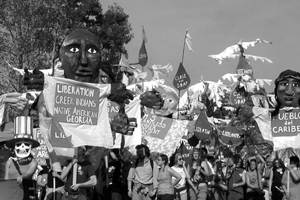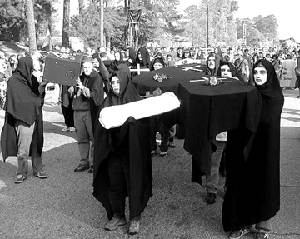|
|
|
|
Closing
the School of the Americas: A Protest Report
by Danielle Chynoweth |
|
|
|
 |
|
On
November 18, nineteen residents of Champaign-Urbana joined
over 10,000 people from around the country who had traveled
to Columbus, Georgia to call for the closing of the School
of the Americas, recently renamed the Western Hemispheric
Institute for Security Cooperation, or WHISC. Despite
fears that the attacks of September 11 and the subsequent
curbing of civil liberties would hamper this year’s
demonstration, it was the largest gathering in the 11
years of protests coordinated by the School of the Americas
Watch organization. The city of Columbus had originally
denied a permit for this year’s demonstration at
the gates of the School, citing the current war in Afghanistan
as its reason. But in the end, a federal judge upheld
the First Amendment right of the demonstrators to use
the roadway as a forum for political dissent.
The day following this ruling, thousands marched in a
solemn funeral procession to the gates of the Fort Benning
army base, which houses WHISC. The procession is held
annually on or around November 16, to commemorate the
date that six Catholic priests and two women were murdered
in El Salvador in 1989. A U.S. Congressional task force,
which investigated the murders, found that those responsible
were trained at the School of the Americas, the Army’s
school for soldiers from Latin America. More recently,
a 1993 |
|
|
|
Fighting
for the living, mourning for the dead: protesters march
with puppets, banners, masks, and coffins outside the
gates of the School of the Americas in Columbus Georgia. |
|
|
 |
|
|
|
|
United
Nations Truth Commission report revealed that SOA graduates
were also involved in the assassination of Archbishop
Oscar Romero, the rape and murder of four churchwomen
of the Maryknoll order, and the massacre of an entire
village of 900 in El Mozote, El Salvador, as well as a
number of other atrocities.
During the funeral procession, protesters chanted the
names of victims of massacres linked to SOA graduates
- a list which took over two hours to complete. Several
dozen people attired in funeral garb and carrying coffins
enacted a mass “die-in” outside the gates of
the army base. Military police filmed participants as
they risked arrest to decorate the gateswith crosses bearing
the names of victims. Two girls tied a weaving to the
gate. Each strip of cloth bore the name of a victim of
the El Mozote massacre. A young man scattered corn seed
through the holes in the fence, explaining his gesture
as an act of “solidarity with those in Chiapas who
are taking over military bases and planting crops where
there should be crops.”
Laura Slattery, as her memorial to the victims of the
SOA, hung her U.S. Army uniform on the fence, complete
with badges and insignia of rank. Slattery served during
the invasion of Panama and the Persian Gulf war, and was
briefly stationed at Fort Benning. As she placed her uniform
alongside the crosses and peace cranes she quietly made
a statement. “I said that I was refusing to continue
to believe that a military solution is any solution at
all, or that bombs and guns do anything more than kill
my brothers and sisters. I spent some time in El Salvador
and I witnessed first hand some of the effects of the
School of the Americas. I wanted to do something to stop
that,” Slattery explained.
In the face of its record of human rights abuses, officials
of the Western Hemispheric Institute for Security Cooperation
insist that WHISC is a different institution with different
training and priorities than its predecessor, the School
of the Americas. Colonel Downie, the commander of WHISC,
argues that “the School of the Americas was focused
on the challenges of the last century. Our focus is on
the challenges of the 21st century. What are those challenges?
It’s peacekeeping; it’s disaster relief; it’s
counter-drug operations. It’s those kinds of operations
that require police forces, military forces, and civilian
agencies to work together.” Downie insists that counterinsurgency
techniques are an “old threat” and no longer
relevant to the school.
Despite these changes, SOA Watch founder Father Roy Bourgeois
maintains that the military training school has “a
new name, but the same shame. It is still a school for
terrorists. It’s still a school for death squad leaders.
It’s still a school for soldiers who are armed and
trained in commando operations, psychological warfare,
and counter-insurgency techniques to go back to Latin
American and provide the muscle for U.S. corporations
and U.S. foreign policy.” Bourgeois focuses his current
criticism of WHISC on its role in the U.S. intervention
in Colombia. Ten thousand members of the Colombian military
were trained at WHISC in the past year, making up the
bulk of trainees.
During the demonstration, fifty members of a group called
the Christian Peacemakers dutifully “washed the American
flag of its sins”, while singing of and confessing
their own “complicity” with the U.S. attempt
to “wash away its sins” by merely changing the
name of the SOA, they explained. Eighteen of the fifty
proceeded to climb underneath the fence and onto the base.
Walking on their knees, they presented the cleansed flags
to the military police who arrested them. Other clusters
also performed slow, composed acts of civil disobedience
while crossing onto the base. A total of eighty were taken
into temporary custody by military police, and received
orders barring them from returning to the base. Of those
who had previously been barred, fourteen face up to a
year in federal prison for their return.
Outside the gates, demonstrators constructed a “global
village” complete with composting toilet and cardboard
hospital. The village was erected “to demonstrate
a desirable world community free of violence,” one
villager explained. Thirty-one participants were arrested
when they refused to clear the street. Those arrested
fasted until they were released two days later with no
fines and credit for time served. Twenty-six participants
in previous protests against the SOA remain in federal
prisons, serving terms of three months to a year.
In 1999 the U.S. House of Representatives voted to cut
the SOA’s funding, but this vote was narrowly overturned
in a House-Senate Committee. Currently there is a resolution
to close WHISC, the successor of the SOA, and to create
a task force to assess appropriate training and education
for Latin American military personnel. House Resolution
1810 has 87 co-sponsors in the House. Last May an Executive
Comment on the Resolution was requested from the Department
of Defense. There has been no formal movement on the resolution
since.
The author
has created a radio documentary of the SOA protests
for the IMC Newshour (Mondays at 6 pm on WEFT 90.1 FM),
which is also available on CD at the Urbana-Champaign
Independent Media Center.
|
|
|





